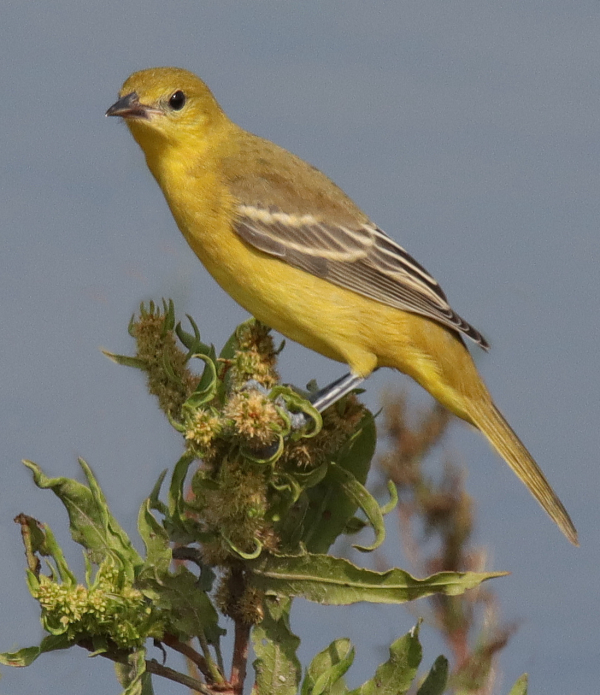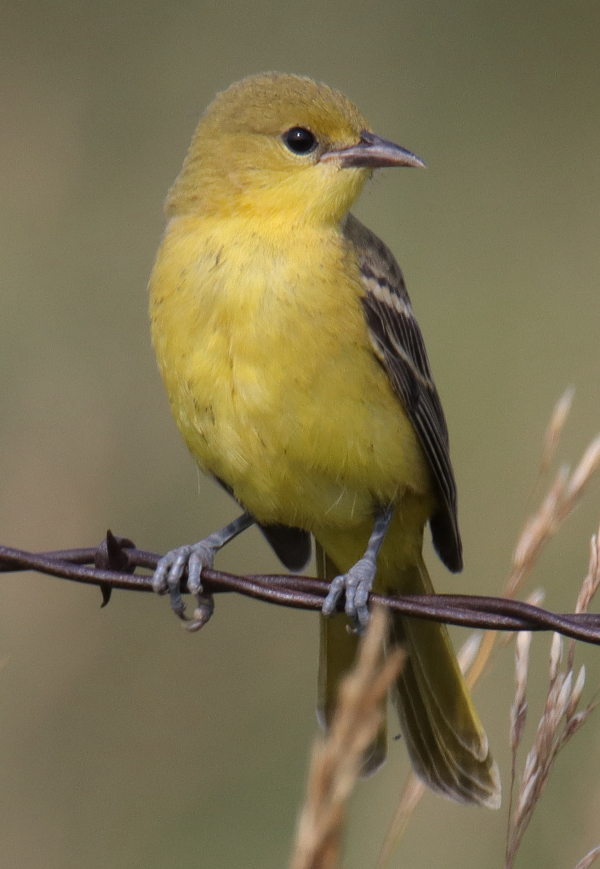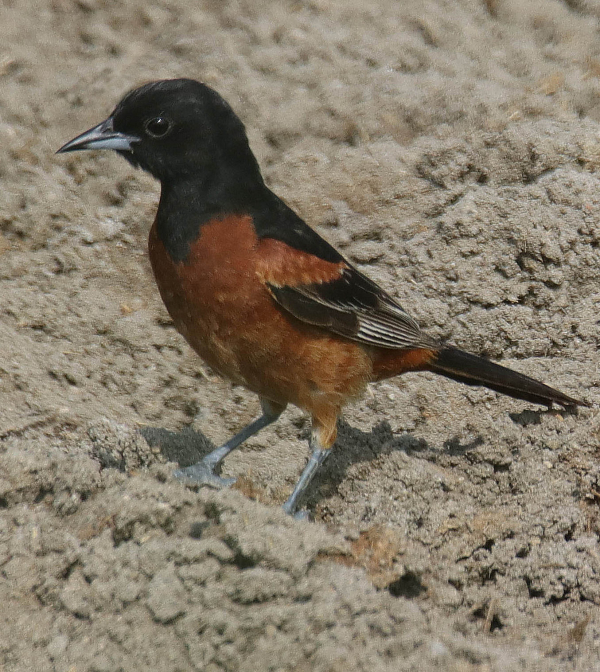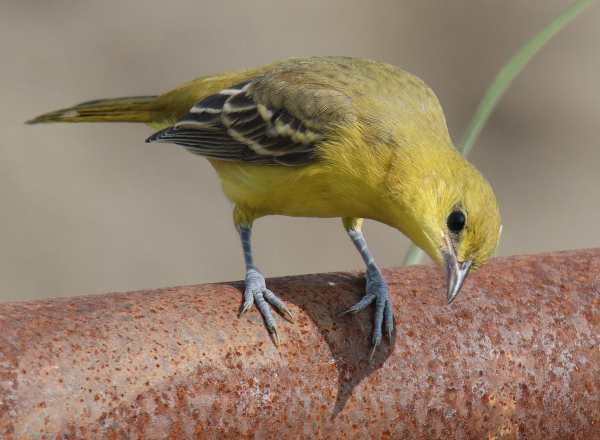
After waiting for the chance to photograph fledgling orioles in his yard, Paul had a variety of opportunities to photograph recently fledged Orchard Orioles still associated with the adults during the post-fledging period.

Even when encountered a dozen miles from home, the orchard orioles perched on man-made structures – a rusty gate and a barbed wire – but that doesn’t detract from the beauty of these attractive songbirds.

Although it is nearly impossible to tell a fledgling Orchard Oriole from an adult female, brighter colors and fresh new feathers usually indicate a fledgling.

A fledgling reacted quickly to begin food-begging when an adult male with an insect in its bill arrived on the scene.

The male Orchard Oriole paused for a moment after feeding the still-begging fledgling, requiring a quick reaction time to take a quick portrait.

The inquisitive look of this fledgling Orchard Oriole is endearing, but don’t miss the shadow of its face that shows below the bird.
|
One of the most rewarding ways to get the most out of your backyard birding experiences is to try to get photographs of some birds that visit your yard, including photos of birds that visit your feeders. It’s fun, it can be exciting, and it’s not as easy as someone unfamiliar with the activity might imagine. In fact, it’s just as hard and sometimes harder to photograph birds in your yard and at your birdbath or feeding station than it is in more rural, “wild areas.” Even so, there is certainly a cross-over for some species that frequent feeding stations and wild areas. As a case in point, we thought we’d turn this week’s Backyard Birding article over to our editor to share a little different spin on “backyard bird” photography.
Paul here: I wanted to share a different angle and an insight or two about photographing birds that visit our yards and feeders – our backyard birds. You may already know that from mid-May to late summer I’m a big oriole fan, and my favorite feeding station visitors are the Baltimore and Orchard Orioles that are attracted to the grape jelly I provide at my oriole feeder. I had pretty good success photographing orioles at my feeding station after the first migrating orioles arrived in mid-May, until about the end of May when the leaves on my mature trees formed something of an umbrella around my front yard and the side yard where my feeders and water basin are located.
Since then, I have enjoyed an excellent local population of nesting orioles visiting my jelly feeder, but my photo chances dimmed with the lack of sunlight when my yard became mostly shaded. Now my oriole population has dwindled to 4 birds max, with only 1 truly regular visitor, a female Orchard Oriole. I’ve also been interested in photographing fledglings in my yard, but this season no adult orioles have brought fledglings to my feeding station or surrounding trees. But what I’m getting at is that in addition to being favorite feeder birds, Orchard Orioles can also be encountered regularly in the field in some surrounding rural areas.
In fact, last week I had a big breakthrough: Suddenly I was surrounded by Orchard Orioles – first an adult male that was drinking, then bathing. Then a fledgling that was hard to tell apart from an adult female perched nearby; and soon the fledgling joined an adult female that it begged for food from before they both drank and bathed in tandem. Eventually the adult female left, but the fledgling remained; and that’s when an adult male flew in with food for it, which solicited a food begging display from the fledgling. The adult male passed the insect to the fledgling, then stood on the bare ground long enough for me to photograph it. All this photo action took place over a period of just a few minutes as I photographed in earnest, providing my best Orchard Oriole photos of this year in addition to some of the most interesting behavioral observations between fledglings and adults.
Beyond the Backyard
The catch was that although these were “backyard birds,” they weren’t in my yard; they were 12 miles away from my yard, yet you may not know it from the photos. I guess my point is that we can photograph species that frequent our yards and feeders while separated from our property, perhaps expanding our areas of interest and visitation in the process. And realistically, the lighting was better than I usually get in my yard, even under the best conditions there.
This fine Orchard Oriole photo session took place while I was parked on the edge of a favorite wetland where I have been photographing shorebirds and duck broods; but with a few hot, dry days in a row I noticed an increase in songbirds visiting the location to drink, bathe, and cool down a bit. Then, especially when the orioles began arriving, my photo reflexes went into high gear and the Orchards were most appropriating as they were active within focus of my zoom lens.
Whether this is a good example of how we all can find enhanced experiences when we expand our horizons a bit more, to get to know how the birds we see daily are dispersed across the surrounding countryside, or suburbanside, and what habitats they are utilizing beyond our yards, feeders, and water sources. It’s also a good example of how photographing birds can add a new dimension to your birding activities – truly, a visual dimension. Taking photos of the orioles was fun, exciting, and rewarding, especially when I saw how well the images of the birds turned out.
Now I can share them with my friends and family, and with you and other readers who I sincerely enjoy sharing photographs of birds I encounter with my camera week after week. You may even have a better photo setting in your yard than I have in mine this time of the year, but even so, see what birds you can find beyond your regular backyard habitat, and bring a camera. Oh what fun it is to photograph birds, in your yard, as well as beyond your property.
Article and photos by Paul Konrad
Share your backyard birding experiences and photographs with The Birding Wire at editorstbw2@gmail.com